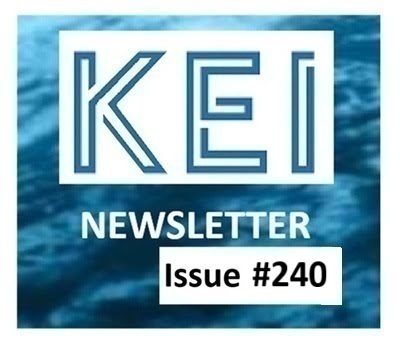|
ENERGY SOVEREIGNTY - Powering Intelligence in an Integrated World |
DIRECTORY | ||
|
CONTRIBUTIONS: SOVEREIGNTY under Siege - Robots At the Door |
ACTION: Help sustain KEI's contributions |
Fact or Fiction?
US Tariffs Backfire HERE AI Wave to Crest HERE |
|
|
Editor - Perry Kinkaide |
Energy fuels everything — from sunlight to supercomputers. As AI’s hunger for computation rivals nations’ energy demands, control over power grids has become control over intelligence itself. This article and the associated webinar examines nuclear renewal, fusion breakthroughs, and hybrid thermal systems as pathways to sustainable independence. The shift from extraction to integration — from oil and gas to intelligent energy networks — marks not just a technological transition but a geopolitical one. |
||
|
Sovereignty will belong to those who balance energy, intelligence, and foresight. Survival may warrant attending to the warning cited in the Fact or Fiction feature: the AI Tsunami is Unsustainable with the gargantuan appetite for energy the culprit. — Editor |
|||
|
ENERGY SOVEREIGNTY - Powering Intelligence in an Integrated World
Energy fuels everything — from the sun that powers photosynthesis to the synapses firing in our brains. And now, as artificial intelligence expands across every sector, the digital world is beginning to mirror the biological one in its voracious appetite for energy. Humanity’s own creation — AI — is fast becoming the globe’s newest energy giant.
AI as an Energy Consumer. For the brain, energy sustains thought. For the world, AI demands the same — computation as consumption. The $trillions being invested in hyperscale data centers are not simply tech plays; they are the new energy infrastructure. Training a single frontier AI model now consumes as much power as 100,000 homes. As AI’s intelligence scales, so too will its carbon and cooling costs.
The race is on for green compute — to match computational growth with sustainable power. Nations and corporations are revisiting nuclear energy and fast-tracking small modular reactors (SMRs) as stable baseload companions to solar and wind. Even fusion — once a perpetual promise — is now drawing billions in private investment, inching toward commercialization by the 2030s. Continued below
No need to register. Just Zoom in https://us02web.zoom.us/j/84258596166?pw..
Continued from above The Return of Nuclear and the Promise of Fusion. After decades of hesitation, nuclear energy is regaining its social license. In Canada, Ontario’s refurbished CANDU reactors, Saskatchewan’s SMR initiatives, and Alberta’s exploration of micro-reactors for remote operations signal a pragmatic shift. Around the world, modularity and safety advances — like molten-salt and thorium designs — are redefining nuclear’s image from liability to necessity. Meanwhile, fusion energy, long the “holy grail,” is edging from physics experiment to potential economic disruptor. AI-driven modeling and bioscience-inspired material design are accelerating this transformation — the same kind of hybrid thinking explored in Integrating Computing and Bioscience, where energy-efficient biological architectures inform how we might rethink computational and energetic efficiency together. The Decline of Energy Nation-States. For much of the 20th century, power meant oil — and oil meant geopolitics. The rise of renewable diversification, battery storage, and decentralized microgrids is eroding the dominance of traditional energy states. Saudi Arabia’s Vision 2030, Russia’s pivot to Asia, and the U.S. Inflation Reduction Act all underscore this structural shift: energy is no longer bound by borders or barrels. Canada, too, is facing an identity test. Once a global energy exporter, its policy paralysis on pipelines, tanker bans, and carbon intensity debates risks turning opportunity into dependency. As commitments to “halt climate change” soften amid war, inflation, and public fatigue, Canada’s regulatory rigidity is being rethought. The tone is shifting from prohibition to balance — from ideology to integration. Taking a Closer Look: Canada’s Energy Crossroads. The global transformation of energy systems has local consequences. In Canada, the contradictions are sharpening. There is a growing recognition that Canada is not on track to meet its greenhouse-gas reduction targets nor is it likely to be able to fuel the pending AI tsunami. The path forward cannot rely on electrification alone. Electrification vs. Adaptation. Electricity utilities across Canada are now acknowledging a hard truth: electrification of building heating at scale may be nearly impossible. The generation and distribution expansion required would be immense, while utilization of the grid would collapse. In Ontario, for instance, system utilization could drop from 67% today to roughly 26%, driving up prices dramatically. A recent Boltzmann Institute report, “What We See Down Two Pathways,” compared electrification with thermal network solutions and found that thermal systems could deliver heating more adaptably, resiliently, and at nearly half the cost. Not only would this approach curb the need for massive grid expansion, it would also generate new revenue streams for thermal-electric power plants configured as combined heat and power (CHP) systems. The Nuclear Link: A Catalyst for Thermal Networks. While much of the attention has turned to nuclear CHP, it is because key design and investment decisions are being made now. Recent studies in the UK found that incorporating CHP capability into new nuclear plants could be achieved at an incremental cost of only 0.2% — a modification now endorsed by Canadian nuclear specialists. These designs could act as catalysts for thermal energy networks capable of harvesting industrial and data-centre waste heat alongside locally available renewable sources. The integration of planning, design, and operation of both electricity and thermal systems could stabilize, even lower, electricity prices while delivering affordable, decarbonized heat to communities and industries alike. Regional Momentum: Alberta’s Leadership Potential. In Alberta, where Michael and others have been active in district-energy evaluations in Edmonton and Calgary, opportunities abound. The province’s extensive engineering expertise and its mix of natural resources make it well-suited to hybrid systems — integrating biomass, solar thermal, and CHP for local grids. These systems could recycle industrial heat, capture waste energy from data centers, and contribute to municipal decarbonization while spurring new jobs and investment. Integration Over Ideology. The lesson for Canada — and the world — is that energy transitions cannot be driven by ideology or by single-source dependency. The future belongs to integrated energy systems — flexible, intelligent networks that balance nuclear, renewables, thermal recovery, and fossil fuels where appropriate. AI will play a central role in synchronizing these systems, optimizing flows, and ensuring reliability, much as it does in biological networks. Energy, War, and Survival. Energy is not only about comfort — it is about control. From Ukraine to the Middle East, energy flows still finance conflict. But the next frontier war may be waged not for oil, but for computation — for access to chips, servers, and the power to run them. In this sense, energy is becoming the currency of intelligence. Energy as Evolution. The world is entering an energy transformation — one that transcends fuel types. It is a shift from extraction to integration, from national power to distributed intelligence. Canada, with its rich resources, nuclear expertise, and emerging capacity for AI-driven planning, stands at a pivotal crossroads. The question is not just one of Sovereignty, but of whether it will lead in designing this energy-intelligence nexus — or watch as others define it. In the end, energy and intelligence are one and the same story: both are the capacity to survive — to change, to evolve, to think, essential to Canada's sovereignty.
How Canada can convert the 51st state threat into a sovereignty saving, economic opportunity? Join us in Victoria as we continue the dialogue. Seating is limited to 40 Max. BUT you are invited. FOR MORE and/or for adding your group to the schedule of future dinners please contact Admin@KEInetwork.net
|











